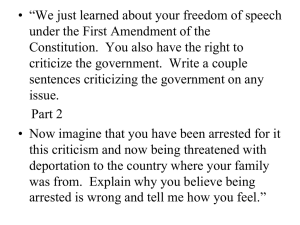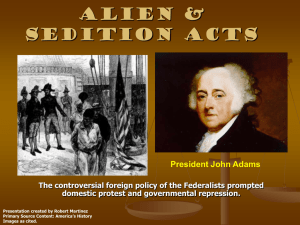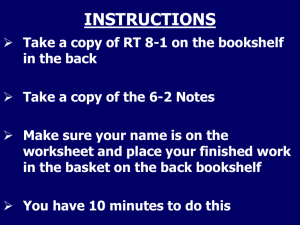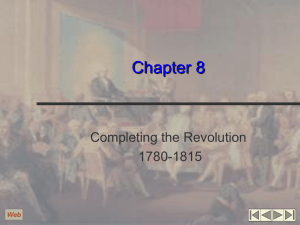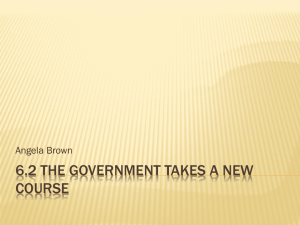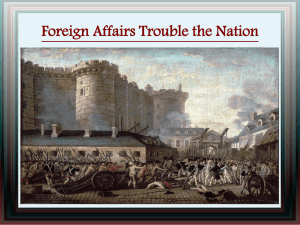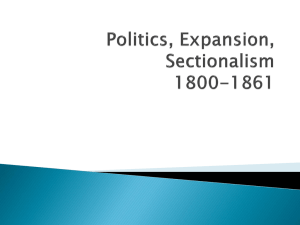APUSH Ch. 7 Review
advertisement
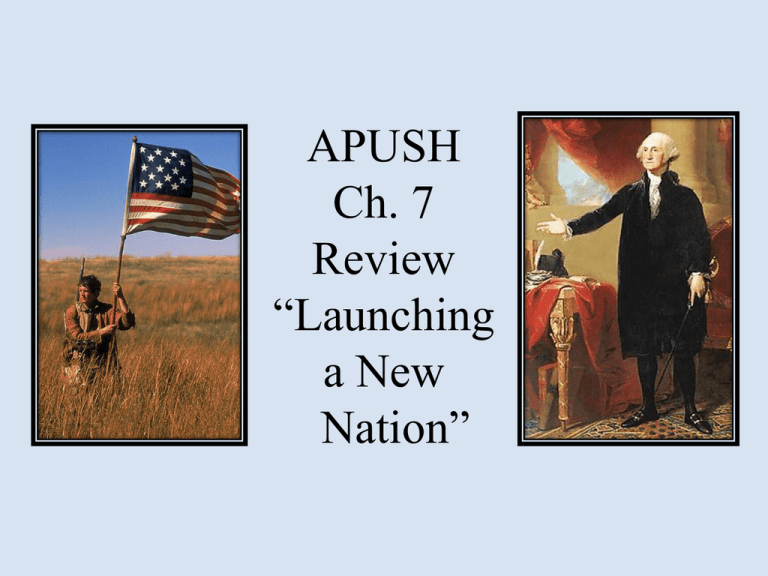
APUSH Ch. 7 Review “Launching a New Nation” Constitutional Govt. Takes Shape • Defining a Presidency – Washington won; John Adams came in second and became the Vice-President (this rule later over-turned by the 12th Amendment) – First cabinet included only Sec. of Treasury Alexander Hamilton, Secretary of State Thomas Jefferson, and Secretary of War Henry Knox (and Attorney General) – Washington’s reputation for honesty and his proposing of few laws and rare use of veto calmed people’s fear of too strong of a leader The Federal Judiciary • Congress given power to establish federal courts lower than the Supreme Court • Judiciary Act of 1789 set up a federal district court in each state • Constitution protected against ex post facto laws and bills of attainder (that proclaim a person’s guilt and punishing them without a trial) • It did not originally have a Bill of Rights • Chisholm v. Georgia – Supreme Court ruled that non-residents could sue a state in federal court (over-ruled by the 11th Amendment in 1798) • Added to get New York and Virginia to ratify the Constitution • James Madison played a large role in the drafting of them 1st – freedom of press, speech, religion, assembly and petition 2nd – right to bear arms 3rd – no quartering of troops 4th – protection against illegal searches and seizures 5th – no person required to testify against themselves 6th – right to speedy, public trial 7th – trial by jury in civil cases 8th – no cruel and unusual punishment 9th – this list of rights does not imply other rights are to be denied 10th – every other power not denied by Constitution or given to the national govt. are to be given to states Hamilton’s Financial Plan (see other power-point) 1. Whiskey Rebellion • Cause – national debt from Revolutionary War led to Hamilton’s Financial Plan that included an excise tax on whiskey, which led western farmers to rebel against tax collectors • Solution – Washington sent Hamilton and 13,000 troops to put down the rebellion, and 150 were arrested and the rebellion died down quickly • Effect – it limited public opposition to federal policies, asserted federal control, and proved the govt. under the Constitution would be significantly stronger than the one under the Articles which didn’t respond to Shay’s Rebellion 2. Relations with Spain (to 1794) • Andre Fagot (fah-go) – Spanish agent sent to bribe Americans with land grants in what is now the Southeast (Tennessee and south) to secede from the Union • Spain didn’t allow Americans to trade in New Orleans until 1789 (and then only by paying a 15% duty) • Treaty of New York – separate treaty in 1790 with Creeks in Southeast to allow American settlers to remain where they were and keep Creek territory independent (to undermine their relations with Spain) • Spain eventually got the Creeks to renounce this treaty • French Revolution in 1789 – split US over whether we should support the monarchy that supported our war for independence, or whether we should support a new republic with democratic ideals • South more anti-British and proFrance due to British stance on slavery and St. Domingue slave uprising • North more anti-French due to Protestant religious upbringing that made them appalled by the violence of the revolution and due to trade ties to the British • France declared war on British and Spanish in 1793 making the issue more hotly debated • Washington officially declared the US neutral 2. Relations with France and British 2. Relations with France and British (continued) • Citizen Genet – sent by France to US in 1793 to gain support for French and to get Americans conquer Spanish territory and attack British shipping (many American privateer ships seized British vessels and many American mercenary soldiers were hired) • British impressment (forced enlistment of American sailors on US ships into Britain’s Royal Navy (partly due to privateers) • British still maintained a fort (Fort Miami) on American soil (near current site of Toledo, Ohio) and for supplying tribes in Ohio Valley and inciting them to resist white settlement there 3. Initiative #1 & #2 • (#1) Washington sent General Anthony Wayne to negotiate a treaty with Shawnee and Ohio Valley allies • Instead the Battle of Fallen Timbers took place in 1794, which was won by Wayne’s forces • Treaty of Greenville – (1795) signed after the battle which opened Ohio for white settlement • (#2) Washington sent Chief Justice John Jay to negotiate with Great Britain (result was Jay’s Treaty – more on this with Question #5 answer) 3. Initiative #3 • (#3) Washington sent Thomas Pinckney to Spain to negotiate a treaty • Treaty of San Lorenzo (more commonly called Pinckney’s Treaty) won westerners the right of unrestricted, dutyfree use of the Mississippi River, and it set the southern border of US at 31st parallel • Also, Spain agreed to dismantle forts north of the line and to discourage Indian attacks against American settlers there • The treaty was an undisputed diplomatic victory for Washington 4. Election of 1796 • Federalists attempted to identify the DemocraticRepublicans with the violence of the French Revolution’s Reign of Terror (as D-Rs were supporters of the young French Republic) • D-Rs accused the Feds. of favoring aristocracy, and denounced the Feds. over Jay's Treaty (too favorable to Britain) • (For more detail see “2 Party System” handout and upcoming slide on the results of the Election of 1796) TWO PARTY SYSTEM EMERGES Democratic-Republicans basic ideas come from those of Secretary of State Thomas Jefferson Federalist basic ideas come from those of Secretary of Treasury Alexander Hamilton Washington’s Farewell Address • It was written near the end of his second term as President and before his retirement • He urges the people to place their identity as Americans above their identities as members of a state, city, or region • He warns against political parties because of their tendency to distract the government from their duties, create unfounded jealousies among groups and region • He urges the US to avoid long-term friendly relations or rivalries with any nation, and argues that alliances are likely to draw the US into wars which have no justification and no benefit to the country 5. Jay’s Treaty • 1794 treaty between the US and Great Britain that facilitated 10 years of peaceful trade between them in the midst of the French Revolutionary Wars, which had begun in 1792 • It gained primary US goals: – the withdrawal of the British Army from forts in the NW Territory – disputes over wartime debts and the American-Canadian boundary were to be sent to arbitration • It didn’t resolve the issues related to impressment • Though it avoided war with the British it did provoke the French against us 5. Election of 1796 DemocraticRepublican Jefferson became VP Federalist Adams became Pres. • 1st contested US pres. election, so both parties campaigned heavily for their candidate • Adams a pro-British Federalist won • Only time a president and VP were elected from opposing parties (remedied by 12th Amendment) • Immigrant votes for DemocraticRepublicans in NY nearly swung the election to Jefferson • As more and more immigrants were coming, this was a disturbing trend for the Federalists moving forward 5. XYZ Affair • In 1798 President Adams sent a peace commission to France, but 3 unnamed French officials (nicknamed X, Y, and Z) demanded a bribe and an apology to open discussions • This insult helped lead to an undeclared naval conflict in the Caribbean Sea called the QuasiWar, which raged at sea from 1797 to 1800. • The Federalist Party took advantage of the national anger to build an army and pass the Alien and Sedition Acts to damage the rival Democratic Republican Party The cartoon above depicts a fiveheaded monster, representing the Directory that ruled France in 1797, demanding payment of a bribe from the three US representatives. 5. Effect of These Events • Jay’s Treaty avoided war with the British and provoked France • Federalists won the Election of 1796 putting our govt. on the British, not French side • After XYZ Affair France was seen as the enemy (and in fact was in the Quasi War) • All of this helped the Federalists sweep to victories in the midterm elections of 1798 6. Alien and Sedition Acts • The Naturalization Act –extended the duration of residence required for aliens to become US citizens from 5 years to 14 years (to reduce immigrant support of Four bills passed by the Federalists Democratic-Republicans) and signed into law by Adams in 1798 during the Quasi-War, which • The Alien Act – authorized the president to deport any resident Federalists viewed as war measures alien considered "dangerous to the peace and safety of the US” • The Alien Enemies Act – authorized the president to deport resident aliens if their home countries were at war with the US (to target French) • The Sedition Act – made it a crime to publish "false, scandalous, and malicious writing" against the government or its officials (to target D-Rs criticism of Adams) 6. Republican Arguments Against • Virginia and Kentucky Resolutions argued for strict interpretation of the Constitution and for states rights • 10 years before, the AntiFederalists had warned that the – interposition – US states Constitution had made the had to protect their rights federal govt. too strong; now against federal violation with Alien and Sedition Acts and – nullification – states can the Federalists controlling all 3 refuse to obey federal laws deemed unconstitutional branches of govt. it seemed like they were right (They were secretly written by • Alien and Sedition Acts took VP Thomas Jefferson and by away first amendment rights of James Madison) free speech • Virginia and Kentucky Resolutions argued the following 2 points in relation to the Alien and Sedition Acts 7. Main Issues of Election of 1800 • Adams began peace negotiations with France during the Quasi War – against advice of many Federalists who thought he should declare war against France – this lowered argument against D-Rs and their general support of France • Nation near civil war with south and west approaching secession (due to anger over the Alien and Sedition Acts) • National debt of federalists seen as main issue as danger of war with France faded • All of these hurt Federalists President John Adams 7. Election of 1800 Adams 68 Electoral Votes Jefferson Burr 73 Electoral Votes 73 Electoral Votes • Voter turnout jumped from 15% in 1796 to 40% • Election resulted in tie between Dem-Reps. Thomas Jefferson and Aaron Burr when the 73 D-R electors voted for both Jefferson and Burr, (Burr was supposed to be left off one D-R ballot to finish 2nd for Vice President) • That sent the election to the House of Reps., where Burr sought Federalist votes against Jefferson to steal the election • 35 ballots over 5 days finally ended when Hamilton (Burr’s bitter NY state rival) declared his support for Jefferson giving the Presidency to his rival Jefferson • “Revolution of 1800” – refers to the peaceful transition of power from one political party to another for the first time in our nation’s history 8. Economic Changes late 1700s • Boys did field work on family farms and women did the childrearing • Industry took place within households, usually to provide extra income in winter • Women often did this work which was the making of things like shoes and basic clothing • Began sometimes due to boycotts of British goods • Catered to urban consumers and slave owners 9. Women • Legal position of white women hadn’t changed though it was easier for some to gain a divorce • New Jersey repealed the right of women to vote in 1797 • Fewer arranged marriages took place (young men were heading west for land leaving a shortage of prospective husbands) • Fewer children than in previous generations (due to smaller farms and urbanization) • Republican motherhood – women had the role of educating children in the values of liberty and independence 9. Native Americans • During Washington’s Presidency Congress attempted maintain good relations by prohibiting trespassing on Native Americans’ land, and by regulating trade (Indian NonIntercourse Act of 1790) • Native Americans became demoralized after losses in battle and due to disease • Violence and heavy drinking became more prominent in their communities • More land was taken from them • Pressure to give up traditional ways of life or adopt aspects of white culture led to huge conflicts within tribes • In 1799 Seneca prophet Handsome Lake (left) preached against alcoholism, and for cultural unity 9. African Americans • First fugitive slave law passed in 1793 • In 1796 all but 3 of 16 states permitted free blacks to vote (would drop sharply in 1800s) • Most states had outlawed the slave trade • Cotton gin (invented by Eli Whitney in 1793) helped entrench slavery • As southern economy grew more tied to sale of cotton, the acceptance of slavery increased and the treatment of slaves worsened • Slave rebellions led to an increasing fear of slaves and also worsened their treatment – Saint Domingue (Haiti) in 1791 – Gabriel’s Rebellion by in Virginia in 1800
